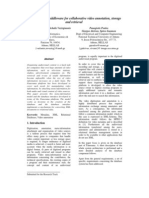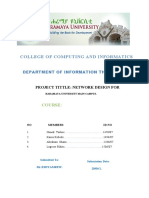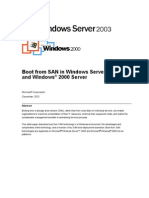Network Development
Uploaded by
Mercedez BenzNetwork Development
Uploaded by
Mercedez BenzCH/S6CA/Nov.
2008
SOHO NETWORK DESIGN AND IMPLEMENTATION
The following phases are involved in the network development process:
i. Need analysis
ii. Design
iii. Setup
iv. Testing
v. End-user support
Documentation is needed in different phases in the network development process.
One can go back to the previous phase(s) if necessary.
Need analysis
Need analysis begins with the acquisition of external information
i. forecasts of how the new network/service will operate;
ii. the economic information concerning costs; and
iii. the technical details of the network’s capabilities
The role of forecasting.
i. It is necessary to estimate the expected traffic intensity and thus the traffic load that the network must
support.
ii. Traffic intensity
a. It is a measure of the average occupancy of a server or resource during a specified period of time,
normally a busy hour.
b. It is defined as the ratio of the time during which a facility is cumulatively occupied to the time this
facility is available for occupancy.
aL
R
where
a is the average arrival rate of packets (e.g. packets/sec)
L is the average packet length (e.g. in bits), and
R is the transmission rate (e.g. bits/sec).
c. A traffic intensity greater than one means that the rate at which bits arrive exceeds the rate bits can
be transmitted and queuing delay will grow without bound (if the traffic intensity stays the same).
d. If the traffic intensity is less than one, then the router can handle more average traffic.
The identified needs should be translated into user requirements and specifications.
SOHO NETWORK DESIGN AND IMPLEMENTATION page 1
CH/S6CA/Nov. 2008
Design
The network should be designed in a way that it can meet every requirement generated in the need
analysis phase.
In the design phase, one should consider (with reference to Notes “SOHO Networking”)
i. network layout
ii. transmission media. (p. 14)
iii. topology (p. 15-16)
iv. protocol(s)
v. network devices
vi. server(s)
vii. software
a. operating system (Windows server, Linux)
b. application software
c. utilities (network monitoring software)
viii. cost
a. setup cost (fixed cost)
b. on-going support cost (variable cost)
ix. security measures
x. scalability measures
xi. internet access (broadband or leased line)
xii. static IP addressing system or DHCP
Network Diagram
i. The network will be built in the setup phase according to the network diagram.
ii. In the above diagram, three personal computers and a server are connected to a switch; the server is
further connected to a printer and a gateway router, which is connected via a WAN link to the
Internet.
iii. The network diagram will be kept updated during the end-user support phase to facilitate on-going
maintenance and support.
SOHO NETWORK DESIGN AND IMPLEMENTATION page 2
CH/S6CA/Nov. 2008
iv. A network diagram may include the following information::
a. Network layout.
b. Category / Model name of network devices / servers / user machines
c. Location of devices / servers / user machines
d. IP address of devices / servers (User IP addresses will not be recorded if DHCP is used)
e. Machine names
f. Transmission media used
g. Other additional remarks are useful for further reference and support.
Cisco uses its own brand of networking symbols:
http://www.cisco.com/web/about/ac50/ac47/2.html
Here are some more sample network diagrams:
SOHO NETWORK DESIGN AND IMPLEMENTATION page 3
CH/S6CA/Nov. 2008
Setup
In this phase, the actual network will be set up. Steps include:
i. Wiring
ii. Physical installation of machines
iii. Installing additional components on machines (E.g. Extra hard disk for RAID, extra power supply_
iv. Software Setup
a. Installing OS
b. Other configurations (E.g. setting IP, joining domain)
c. Setting sharing resources like folders on harddisks.
d. Installing other software
e. To save time, we can install everything on a “template” machine, then clone the image of this
machine to other machines so that all machines will look similar in their settings.
Folder/file-sharing permissions:
Read, write, execute rights, etc.
Testing
Testing is the process used to justify whether the network installed in the setup phase fulfils the
requirements stated in the need analysis phase.
Test Plan:
i. Written before conducting the test.
ii. Used to specify what test cases should be conducted.
iii. Should be drafted according to user’s requirement and the network design.
Test results should be recorded and stored in the Test Report.
End-user support
User training
i. Teacher users how to use the system. E.g. login, print file, etc.
SOHO NETWORK DESIGN AND IMPLEMENTATION page 4
CH/S6CA/Nov. 2008
ii. Tell the users the rules and best practice they should obey in using the system. E.g. password policy,
security policy, etc.
iii. Documents involved: teaching materials, regulation documents.
Ad hoc support
i. Solve uses’ problems upon requests
ii. Supporting details should be recorded in a log for the following purposes:
a. Knowledge sharing between supporting team members
b. For further analysis (e.g. which printer brand goes wrong most frequently)
House-keeping Work. E.g.
i. Regular backup
ii. Server cleanup
iii. Virus engine update
iv. Installing software patches
v. Update the network diagram if there is any change in the network (E.g. Changing router location)
Documentation
Document used in different phases:
Phase Document(s) Remarks
Need Analysis User requirement, Capture requirements from users
specification
Design Network diagram Record the layout of the network and the resources involved
Testing Test plan Include the test cases to be conducted (Done before
conducting the test)
Test report Report the test results (Done after the test)
End-user User manual / Training Teach users how to access the network
support materials
User regulations State the rules users should obey in order to use the network
Maintenance log Is used by supporting staff for recording for further reference
Network diagram When there is any change in the network layout, the network
(updated) diagram should be updated.
Documentation is an on-going process in network development process and should be involved in various
phases in network development.
User document (e.g. user manual and teaching materials) should be easy to read and avoid technical
jargons.
SOHO NETWORK DESIGN AND IMPLEMENTATION page 5
CH/S6CA/Nov. 2008
SOHO Network Management and Security
i. Monitoring, fine-tuning and troubleshooting
ii. Backup
a. Importance
b. Solution, e.g. RAID, UPS, network backup servers, etc.
iii. Security threats and measures
a. Threats: virus, worm, Trojan programs, spyware, unauthorized access, interception
b. Measures: Anti-virus programs, authentication, access and user right control, packet filtering,
public and private key encryption, WEP, IPsec used in VPN, etc.
The major purpose of a database system is to provide users with an abstract view of the system. The
system hides certain details of how data is stored and created and maintained. Complexity should be
hidden from database users.
Data Abstraction
It refers to the suppression of details of data organization and storage and the highlighting of the essential
features for an improved understanding of data
There are several levels of abstraction:
i. Physical Level:
a. How the data are stored.
b. E.g. index, B-tree, hashing.
c. Lowest level of abstraction.
d. Complex low-level structures described in detail.
Reference:
http://en.wikipedia.org/wiki/Entity-relationship_model
http://en.wikipedia.org/wiki/Er_diagram
http://www.edrawsoft.com
SOHO NETWORK DESIGN AND IMPLEMENTATION page 6
You might also like
- How To Spool Into Multiple Files?: Script 1No ratings yetHow To Spool Into Multiple Files?: Script 13 pages
- M4B: SOHO Network Design and Implementation (2) Need Analysis and DesignNo ratings yetM4B: SOHO Network Design and Implementation (2) Need Analysis and Design3 pages
- Introduction To Network and System Administration 1.1. What Is Network & System Administration?No ratings yetIntroduction To Network and System Administration 1.1. What Is Network & System Administration?5 pages
- Explain Network Design Process.: Network Planning and Implementation (3360703)No ratings yetExplain Network Design Process.: Network Planning and Implementation (3360703)8 pages
- © The Institute of Chartered Accountants of IndiaNo ratings yet© The Institute of Chartered Accountants of India15 pages
- Design and Implementation of An Embedded Web Server Based On ARMNo ratings yetDesign and Implementation of An Embedded Web Server Based On ARM4 pages
- X-Database. A Middleware For Collaborative Video Annotation, Storage and RetrievalNo ratings yetX-Database. A Middleware For Collaborative Video Annotation, Storage and Retrieval10 pages
- Network & System Admin ch1 To 10.doc..bakNo ratings yetNetwork & System Admin ch1 To 10.doc..bak92 pages
- Network's Server Monitoring and Analysis Using Nagios: March 2017No ratings yetNetwork's Server Monitoring and Analysis Using Nagios: March 20177 pages
- © The Institute of Chartered Accountants of IndiaNo ratings yet© The Institute of Chartered Accountants of India0 pages
- Chapter 12, Administering Change Chapter 12, Lesson 1 Documenting A Running NetworkNo ratings yetChapter 12, Administering Change Chapter 12, Lesson 1 Documenting A Running Network15 pages
- Enterprise Micro-Service Architecture - CI - CD Orchestration Under Micro-ServiceNo ratings yetEnterprise Micro-Service Architecture - CI - CD Orchestration Under Micro-Service15 pages
- Building The Network Infrastructure For The International Mathematics OlympiadNo ratings yetBuilding The Network Infrastructure For The International Mathematics Olympiad8 pages
- Kalima Jogoo Women Group Management SystemNo ratings yetKalima Jogoo Women Group Management System9 pages
- Chapter 8, Designing and Installing A Network Chapter 8, Lesson 1 Choosing A Network DesignNo ratings yetChapter 8, Designing and Installing A Network Chapter 8, Lesson 1 Choosing A Network Design8 pages
- Assignment Brief 2 (RQF) : Higher National Certificate/Diploma in Computing100% (1)Assignment Brief 2 (RQF) : Higher National Certificate/Diploma in Computing15 pages
- 20240620143305cst 610 Project 4 Technical ReportNo ratings yet20240620143305cst 610 Project 4 Technical Report12 pages
- In My Case: Master - Slave Replication Step by Step100% (1)In My Case: Master - Slave Replication Step by Step4 pages
- MySQL Installation and Server Configurations Step by StepNo ratings yetMySQL Installation and Server Configurations Step by Step3 pages
- Systems Software Worksheet 4 Utility SoftwareNo ratings yetSystems Software Worksheet 4 Utility Software4 pages
- Multimedia Systems: CSC 461/561 Video CompressionNo ratings yetMultimedia Systems: CSC 461/561 Video Compression8 pages
- 128Mb DDR Sdram: HY5DU28422ET HY5DU28822ET HY5DU281622ETNo ratings yet128Mb DDR Sdram: HY5DU28422ET HY5DU28822ET HY5DU281622ET35 pages
- Data Sheet - How To Use PsPing To Test Ping, Latency & Bandwidth Between Blue Prism ComponentsNo ratings yetData Sheet - How To Use PsPing To Test Ping, Latency & Bandwidth Between Blue Prism Components8 pages
- Firewall Design and Deployment: BRKSEC-2020No ratings yetFirewall Design and Deployment: BRKSEC-2020107 pages
- Symantec DLP 14.6 Server FlexResponse Platform Developers GuideNo ratings yetSymantec DLP 14.6 Server FlexResponse Platform Developers Guide54 pages
- C-DAC's Common Admission Test (C-CAT), CDAC C-CAT Preparation - C-CAT Syllabus - C-CAT Notes - C-CAT Online Test SeriesNo ratings yetC-DAC's Common Admission Test (C-CAT), CDAC C-CAT Preparation - C-CAT Syllabus - C-CAT Notes - C-CAT Online Test Series4 pages
- M4B: SOHO Network Design and Implementation (2) Need Analysis and DesignM4B: SOHO Network Design and Implementation (2) Need Analysis and Design
- Introduction To Network and System Administration 1.1. What Is Network & System Administration?Introduction To Network and System Administration 1.1. What Is Network & System Administration?
- Explain Network Design Process.: Network Planning and Implementation (3360703)Explain Network Design Process.: Network Planning and Implementation (3360703)
- Design and Implementation of An Embedded Web Server Based On ARMDesign and Implementation of An Embedded Web Server Based On ARM
- X-Database. A Middleware For Collaborative Video Annotation, Storage and RetrievalX-Database. A Middleware For Collaborative Video Annotation, Storage and Retrieval
- Network's Server Monitoring and Analysis Using Nagios: March 2017Network's Server Monitoring and Analysis Using Nagios: March 2017
- Chapter 12, Administering Change Chapter 12, Lesson 1 Documenting A Running NetworkChapter 12, Administering Change Chapter 12, Lesson 1 Documenting A Running Network
- Enterprise Micro-Service Architecture - CI - CD Orchestration Under Micro-ServiceEnterprise Micro-Service Architecture - CI - CD Orchestration Under Micro-Service
- Building The Network Infrastructure For The International Mathematics OlympiadBuilding The Network Infrastructure For The International Mathematics Olympiad
- Chapter 8, Designing and Installing A Network Chapter 8, Lesson 1 Choosing A Network DesignChapter 8, Designing and Installing A Network Chapter 8, Lesson 1 Choosing A Network Design
- Assignment Brief 2 (RQF) : Higher National Certificate/Diploma in ComputingAssignment Brief 2 (RQF) : Higher National Certificate/Diploma in Computing
- In My Case: Master - Slave Replication Step by StepIn My Case: Master - Slave Replication Step by Step
- MySQL Installation and Server Configurations Step by StepMySQL Installation and Server Configurations Step by Step
- 128Mb DDR Sdram: HY5DU28422ET HY5DU28822ET HY5DU281622ET128Mb DDR Sdram: HY5DU28422ET HY5DU28822ET HY5DU281622ET
- Data Sheet - How To Use PsPing To Test Ping, Latency & Bandwidth Between Blue Prism ComponentsData Sheet - How To Use PsPing To Test Ping, Latency & Bandwidth Between Blue Prism Components
- Symantec DLP 14.6 Server FlexResponse Platform Developers GuideSymantec DLP 14.6 Server FlexResponse Platform Developers Guide
- C-DAC's Common Admission Test (C-CAT), CDAC C-CAT Preparation - C-CAT Syllabus - C-CAT Notes - C-CAT Online Test SeriesC-DAC's Common Admission Test (C-CAT), CDAC C-CAT Preparation - C-CAT Syllabus - C-CAT Notes - C-CAT Online Test Series





























































































